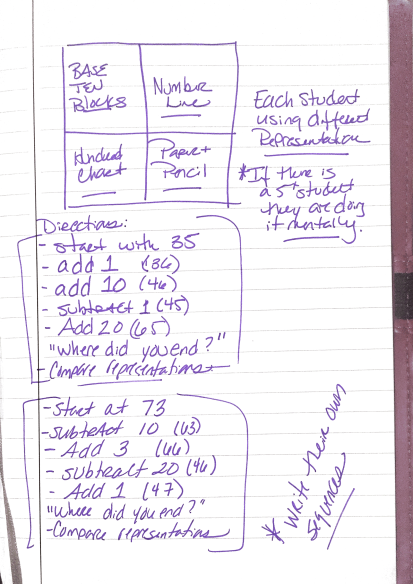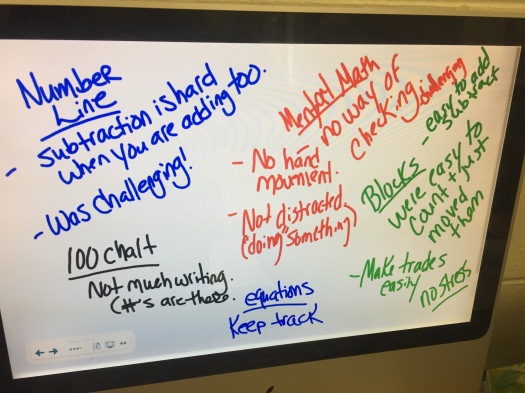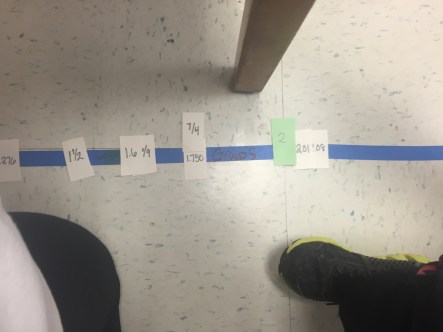There is always a lot of talk about students using an algorithm, process or set of rules, for addition and subtraction. Whether talking about “any algorithm” or “the algorithm,” I am certain, in most cases, people are talking about a process that is absent of tools such as a 100 charts, number lines or base ten blocks. But, what happens when we see the tool becoming an algorithm in and of itself? Can moving left or right on a number line, making jumps of 10s and 1s, writing problems vertically, or jumping rows and columns become an algorithm where students lose sight of the numbers themselves because the process is one more thing to learn?
This was the exact conversation I had yesterday with two 3rd grade teachers as I was leaving school. The students had been playing a game called Capture 5 and struggled making various jumps on the 100 chart. The teacher, understandably, was concerned students were confused about adding and subtracting tens and ones. After more conversation, we began to wonder if the students saw the 100 chart as a set of rules to follow in order to add and subtract instead of a place to look for patterns and structure as we add and subtract. Were they getting caught up in the left, right, up, down movement and losing sight of what was actually happening to the number?
As I thought more about it last night, I wondered about other tools and representations students learn that could easily turn themselves into an unhelpful set of procedures. I also wondered how often we make connections between these tools and representations explicit. Like, when is one helpful over another? How are they the same? How are they different?
I emailed the teacher my notes (below) and we decided we would try this out this morning.

If you can’t interpret from my notes, the plan was to have each student in a group using a different tool or representation as I called out a series of operations to carry out. After the series of addition and subtraction, they compared their answers and discussed any differences. They rotated seats after each series so they had a chance to try out each of the roles.
We came back together to discuss their favorite one. The recording is below…what do I have against writing horizontally, really?? I found this entire conversation SO incredibly interesting!
- They found the base ten blocks to be “low stress” because they were easy to count, move and trade, but did agree that bigger numbers would be really hard with them because there would be too many.
- They really did not like adding and subtracting on the number line with multiple jumps. It got messy.
- They liked mental math because there was nothing (tool) to distract them and they could focus but they didn’t like that you couldn’t check your answer.
- The 100 chart’s only perk was they didn’t have to write the numbers in, they were already there for them.
- I really loved that they mentioned the equations were they only way they could track their work. So if someone in their group messed up, the equation person was the only one that could help them retrace their steps easily.

I am not sure what I learned today, I am still thinking a lot about this. I know that I loved having them compare the tools and representations and that the teacher felt much better about their ability to add 10s and 1s. I feel like there are so many other cools things to do here, but my brain is fried today so that will have to wait!:)



















 So, we could be looking for students to place the beginning and end (0 and 6) first and then I would be curious to see if they placed the middle number before dealing with the other numbers (line 2). Or, would students order left to right, least to greatest (line 3)? Would be interested how they think about spacing the cards in this situation, do they touch? Is there the same distance between each? What would they think about if we gave them a card with 10 on it after they finished arranging them on the line?
So, we could be looking for students to place the beginning and end (0 and 6) first and then I would be curious to see if they placed the middle number before dealing with the other numbers (line 2). Or, would students order left to right, least to greatest (line 3)? Would be interested how they think about spacing the cards in this situation, do they touch? Is there the same distance between each? What would they think about if we gave them a card with 10 on it after they finished arranging them on the line?